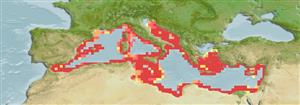Common names from other countries
Classification / Names / Names
Nomi Comuni | Sinonimi | Catalog of Fishes (gen., sp.) | ITIS | CoL | WoRMS
Environment: milieu / climate zone / depth range / distribution range
Ecologia
; distribuzione batimetrica 26 - 498 m (Ref. 1695). Subtropical; 46°N - 30°N, 6°W - 37°E (Ref. 1695)
Mediterranean Sea.
Length at first maturity / Size / Peso / Age
Maturity: Lm ? range ? - ? cm Max length : 2.5 cm ML maschio/sesso non determinato; (Ref. 1695); 2.8 cm ML (female)
Found along the outer shelf between 26 and 498 m depth. Mating takes place when the male grasps the female's 'neck' region, and spermatophores are placed in the female's bursa copulatrix. Males have been observed to guard females during courtship. Contributes (although in low numbers) to the local trawl fishery as one of the most frequently captured Mediterranean species of this genus (Ref. 1695).
Life cycle and mating behavior
Maturità | Riproduzione | Deposizione | Uova | Fecundity | Larve
Members of the class Cephalopoda are gonochoric. Male and female adults usually die shortly after spawning and brooding, respectively. Mating behavior: Males perform various displays to attract potential females for copulation. During copulation, male grasp the female and inserts the hectocotylus into the female's mantle cavity where fertilization usually occurs. Life cycle: Embryos hatch into planktonic stage and live for some time before they grow larger and take up a benthic existence as adults.
Jereb, P. and C.F.E. Roper (eds.). 2005. (Ref. 1695)
IUCN Red List Status (Ref. 130435)
CITES status (Ref. 108899)
Not Evaluated
Not Evaluated
Human uses
| FishSource |
Strumenti
Informazioni ulteriori
Age/SizeAccrescimentoLength-weightLength-lengthMorfologiaLarveAbbondanza
Fonti Internet
Estimates based on models
Preferred temperature
(Ref.
115969): 13.2 - 16.1, mean 14.8 (based on 124 cells).
Vulnerability
Low vulnerability (10 of 100).
Price category
Unknown.
